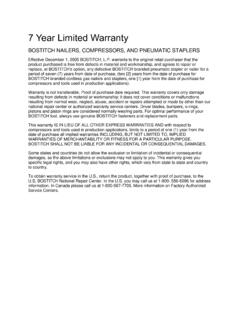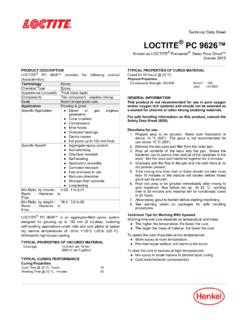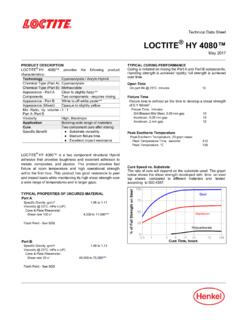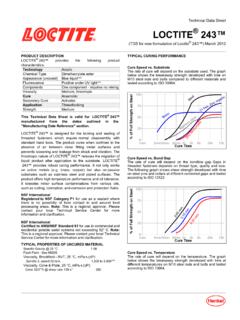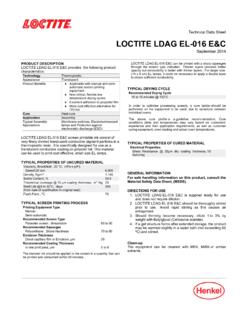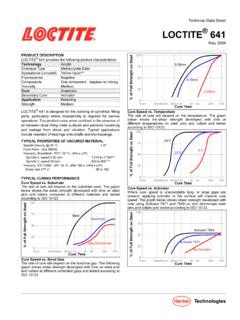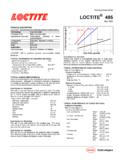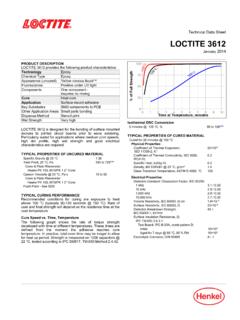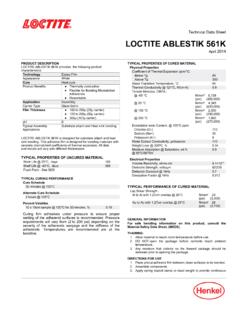Transcription of TECHNICAL DATA SHEET - buymbs.com
1 Revision: October 28, 2013 Supersedes: July 12, 2013 Ref# 440374 loctite PL S10TM Polyurethane Concrete Crack Masonry Sealant Page 1 of 5 TECHNICAL data SHEET loctite PL S10TM Polyurethane Concrete Crack Masonry Sealant is a high quality one-component, texturized, moisture-curing gun grade sealant developed especially for forming permanent, water and weatherproof seals in all exterior gaps and joints in concrete and masonry. The textured appearance blends well with masonry substrates. PL S10 is non sagging and once cured is elastic and remains flexible to expand and contract with construction material movement.
2 loctite PL S10 Concrete Crack Polyurethane Masonry Sealant does not require a primer for concrete, brick, stone or masonry and resists deterioration from weather, stress or movement. Interior and exterior joints, horizontal and vertical joints, expansion joints, panel walls, precast units, concrete walls, foundations, brick and block walls, concrete driveways and sidewalks. Bonds to concrete, masonry, brick, stucco, aluminum, wood and many more substrates. Prolonged underwater applications or permanent water immersion Applications requiring temperature resistance greater than 200 F (93 C) Joint depths greater than (13 mm) without the use of a backer rod Use with fillers impregnated with oil, asphalt, tar or any other migratory saturant Contact with oil-based caulking compounds, butyl caulking compounds, silicone sealants (uncured and cured), polysulfides; fillers impregnated with oil, asphalt or tar.
3 Alcohol-based materials or solvents Applications over freshly treated wood. Treated wood must have weathered for at least 6 months. Copper, stainless steel and galvanized steel typically require a primer. An adhesion test is recommended for any other questionable surface Feature Benefits Textured appearance .. No primer required for most materials .. Easy to gun and tool .. W Does not Low-VOC Compliments rough surfaces like masonry and stucco Use on expansion joints, accepts joint movement of 25% Lowering installation costs Speeding application and making neater joints Withstand harsh environments One-time application, resists age hardening Blends with surroundings Complies to stringent Federal & State Regulatory Requirements DESCRIPTION RECOMMENDED FOR: FEATURES & BENEFITS: NOT RECOMMENDED FOR.
4 Color Item # Package Size Grey 1618522 Paper Cartridge 10 fl oz (295 mL) Grey 1618521 Paper Cartridge 10 fl oz (295 mL) Grey 1675275 Paper Cartridge 10 fl oz (295 mL) PL S10TM POLYURETHANE Concrete Crack Masonry Sealant Henkel Corporation Professional and Consumer Adhesives Rocky Hill, CT 06067 Phone 1-800-624-7767 Fax (440) 250-9661 Revision: October 28, 2013 Supersedes: July 12, 2013 Ref# 440374 loctite PL S10TM Polyurethane Concrete Crack Masonry Sealant Page 2 of 5 For a 10 fl oz cartridge: A (6 mm) diameter bead extrudes approximately ft ( m). A 3/8 ( mm) diameter bead extrudes approximately ft.
5 ( m). Tools Typically Required: Utility knife, caulking gun and tool to puncture cartridge seal. Safety Precautions: W ear gloves. Sealant may temporarily stain skin. Joint Preparation: The number of joints and the joint width should be designed for a maximum of 25% joint movement from the initial joint width. The depth of the sealant joint should be one-half the width of the joint. The maximum depth is inch (13 mm) and the minimum is (6 mm). The maximum recommended joint width is inches (38 mm). See table below. Joint Width (inches) Sealant Depth @ Midpoint (inches) Joint Width (mm) Sealant Depth @ Midpoint (mm) 1/4 - 1/2 1/4 6 13 6 1/2 - 3/4 1/4 - 3/8 13 - 19 6 - 10 3/4 - 1 3/8 1/2 19 - 25 10 - 13 1 1/2 25 - 38 13 In deep joints, the sealant depth must be controlled by Closed-Cell Backer-Rod or Soft Backer-Rod.
6 W here the joint depth does not permit the use of backer-rod, a bond breaker (polyethylene strip) must be used to prevent three-sided adhesion. To maintain the recommended sealant depth, install backer-rod by compressing and rolling it into the joint channel without stretching it lengthwise. Closed-Cell Backer-Rod should be approximately 1/8 (3 mm) larger in diameter than the width of the joint to allow for compression. Soft Backer-Rod should be approximately 25% larger in diameter than the joint width. Backer-rod becomes an integral part of the joint. The sealant does not adhere to it, and no separate bond breaker is required.
7 Do not prime or puncture the backer-rod. Surface Preparation: Surfaces must be structurally sound, fully cured, dry, clean, free of dirt, moisture, loose particles, oil, grease, asphalt, tar, paint, wax, rust, waterproofing and curing or parting compounds, and membrane materials. Protect adjacent areas. Masonry: Concrete, stone, stucco and other masonry must be cleaned where necessary by grinding or wire brushing to expose a sound surface free of contamination and laitance. Concrete must be fully cured. Wood and painted wood: New and weathered wood must be clean and sound.
8 Cut back weathered and treated surfaces and dry rot until clean, sound wood is reached. Scrape away paint to bare wood. Any coating that cannot be removed must be tested to verify adhesion of the sealant or to determine an appropriate primer. loctite PL S10 will adhere to most new and old, dry, oil-free wood. Metal: Remove scale, rust, and coatings from metal to expose a bright white surface. Remove protective coatings as well as any chemical residue or film. Aluminum window frames are frequently coated with a clear lacquer that must be removed prior to the application of loctite PL S10.
9 Any coating that cannot be removed must be tested to verify adhesion of the sealant or to determine an appropriate primer. Remove any other protective coatings or finishes that could interfere with adhesion. Copper, stainless steel, and galvanized steel must always be primed. An adhesion test is recommended for any other questionable substrate. General Preparation: Use above 40 F (4 C). In cool or cold weather, store container where temperature is about 75 F (25 C) for at least 24 hours before using. Cut nozzle at a 45 angle to desired bead size and puncture inner seal.
10 Priming: While loctite PL S10 is generally considered a non-priming sealant, special circumstances or substrates (Copper, galvanized and stainless steel) may require a primer. It is the user s responsibility to check the adhesion of the cured sealant on a test joint before applying to the entire project. W here incidental water immersion may occur, priming is required. Apply primer full strength with a brush or clean, lint-free cloth. A light, uniform coating is sufficient for most surfaces. Porous surfaces, may require more primer, but do not over apply.


